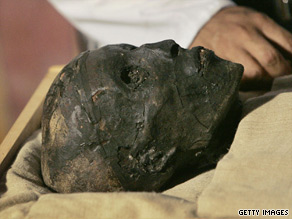
A long line of hospital staff wraps around the corridor outside a small conference room in New York to catch a glimpse of the precious cargo.
Inside are the three frail bodies in open wooden crates causing all the commotion. Another body -- a prince no less -- is a few rooms down in a computer tomography scanner.
The bodies are part of the Brooklyn Museum's collection of 11 Egyptian mummies, transported to the North Shore University Hospital to be scanned. The goal: Find out who they are, how they might have died and establish a chronology of advances in ancient Egypt's mummification techniques.
The process is not necessarily new. Egyptian mummies have been exposed to radiographic study since 1896 and CT scans, which conducts imaging by sections, for more than two decades.
Perhaps the most famous of them, King Tutankhamun (c. 1355-346 B.C.), was scanned in 2005 right outside the vault that holds his sarcophagus. The scan resulted in more than 17,000 images that were analyzed by an international team of radiologists, pathologists and anatomists, led by the world-renowned Zahi Hawass, the secretary general of Egypt's Supreme Council of Antiquities.
The scope and ability of CT scan technology are proving invaluable in learning more about the funeral rituals of ancient Egyptians and the mummies themselves. Whereas conventional X-rays cannot clearly distinguish soft tissue from bone and can see only two planes, CT scanning can differentiate among the various types of bone and soft tissue, and reconstruct three-dimensional images that "show fine detail inside coronary arteries down to 0.6 millimeters" said Amgad Makaryus, director of cardiac CT and magnetic resonance imaging at North Shore, providing a better chance at diagnosis and differentiation among diseases.
"CT has proved to be exceptionally well-suited for studying the fragile, wrapped figures of Egyptian mummies, especially those still contained within their decorated plasterlike shells, or cartonnages," according to an article by a team of eight researchers, led by Derek N.H. Notman, published in the American Journal of Roentgenology.
Read complete story at http://www.cnn.com/2009/TECH/science/06/25/mummy.scans/index.html

1 comment:
Hi, I notice you are discussing mysteries associated with the Church I thought I would mention a book I just read.
We have been led to believe by our ancestors that when Jesus was resurrected he went up to a throne in heaven. However I just read a fascinating book by the New Testament scholar Stephan Huller that in earliest Christianity that the original gospel writer (St. Mark) might have had a physical throne ON THIS EARTH in mind - one which originally sat in Alexandria and which he rediscovered in Venice - see the photos of the object in the Basilica di San Marco which Italian sailors stole from the Church of St. Mark in Alexandria along with the body of St. Mark in 828 AD - see photos of the throne here - http://www.therealmessiahbook.blogspot.com.
The point of Huller's book is that St. Mark was the first Pope and that Jesus ruled 'on his right hand' as he sat on this throne (it is a universally acknowledged - albeit ignored - fact that the title 'Papa' or Pope was originally associated with St. Mark rather than St. Peter and with Alexandria rather than Rome; the bishop of Rome only acquired the title after the fifth century).
I was really fascinated by this book. There are a number of codes, ciphers and symbols on the throne which lead us back to ancient Egypt and the mysteries of Osiris.
It wasn't anything like what I had been taught in school. It really made me think and learn about the language that Jesus and the original gospel writer (St. Mark) spoke.
For instance in Hebrew or Aramaic (the language of Jesus) there would be no way to distinguish the concepts of 'divine throne' or 'heavenly throne' - i.e. it would be easy for white Europeans to get misled or confused.
Moreover the Hebrew word for throne - kisse - is the Aramaic word for cup. Could the mysteries associated with the grail have been originally connected with a throne?
It is an amazing book and here is some background information on the author http://www.stephanhuller.blogspot.com/
Just thought I would pass this along
Peace
Jacob
Post a Comment